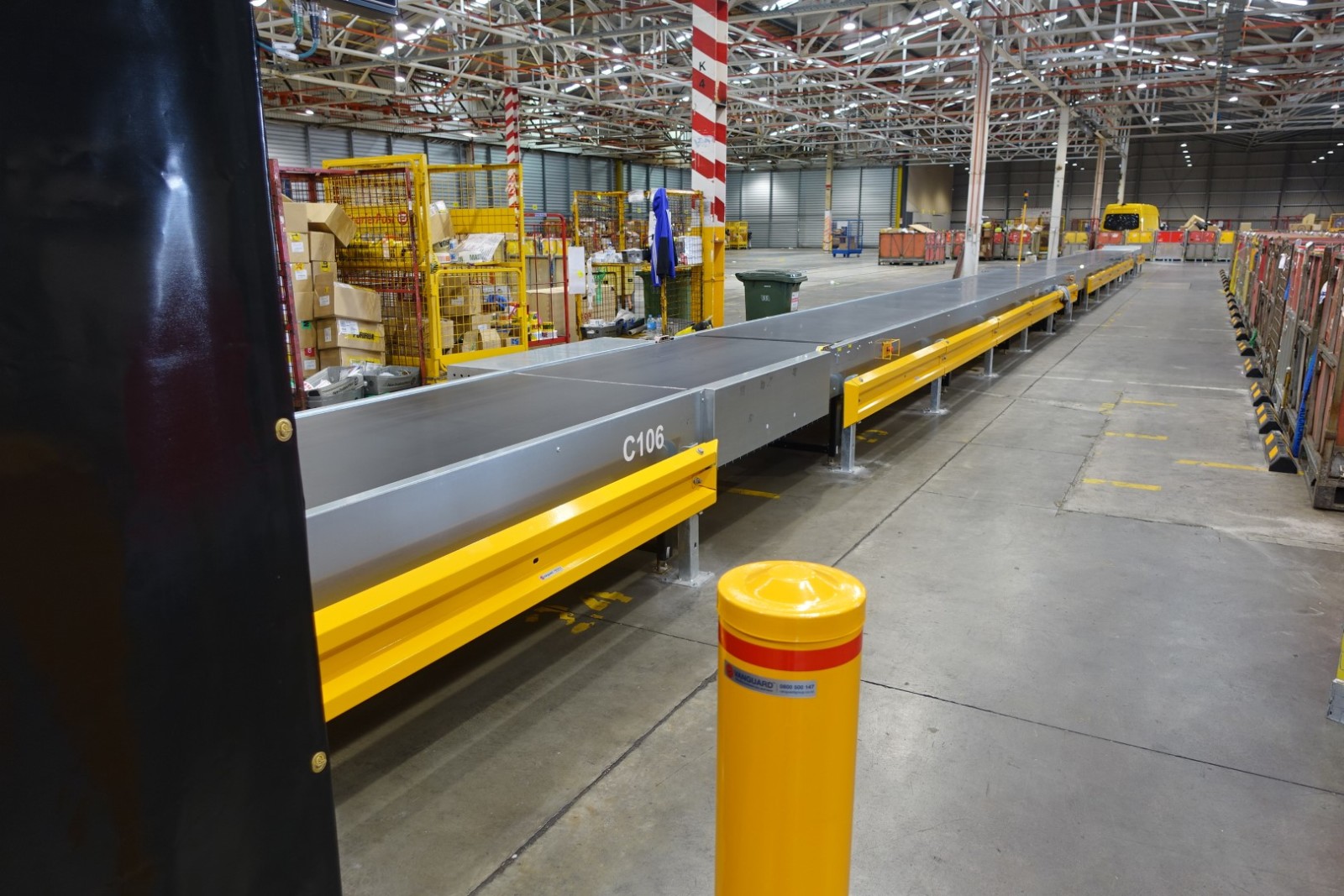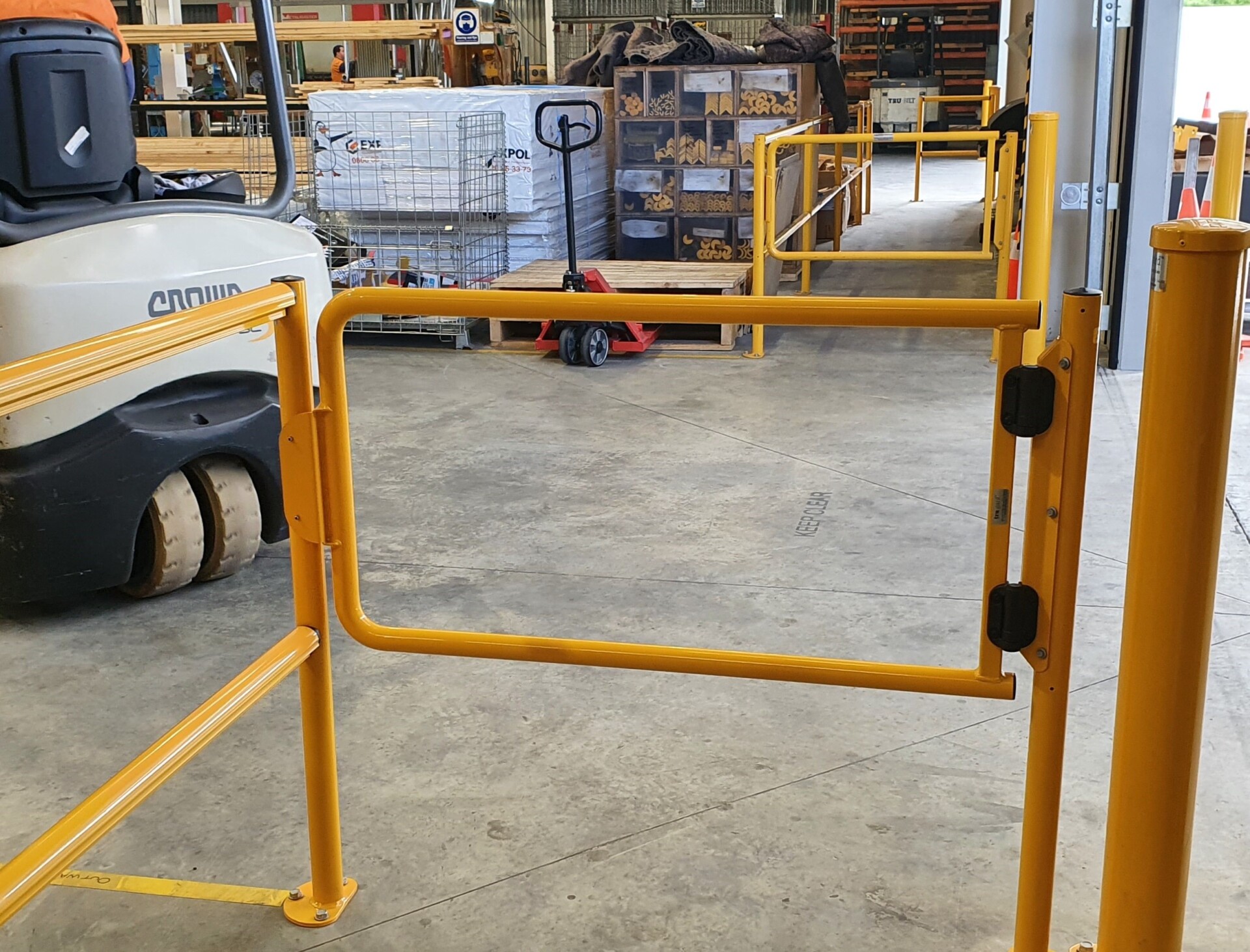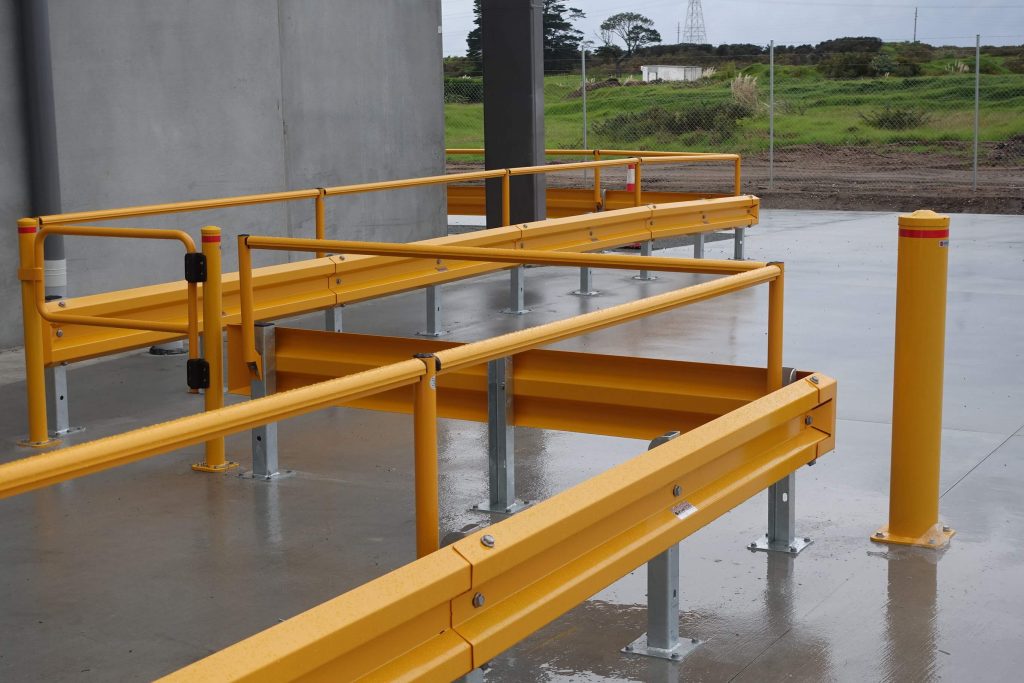Tru-Gard traffic steel barrier system at an agriculture facility.
In workplaces such as warehouses, factories, and construction sites, safety barriers provide an effective way to mitigate risk. They work to separate pedestrians and vehicles and protect users of an area from harm. However, with many different types of barriers available on the market, you may be wondering which option would be most appropriate for the needs of your project. In this blog, we compare the benefits of both steel barriers and flexible barriers and break down the applications they are best suited for to help you decide.
Steel barriers
Tru-Gard traffic steel barrier system protecting a conveyer belt.
Barriers that are made from steel provide strong, stable protection. Using a steel material also provides economic benefits, as it provides a more affordable option. Many warehouses and processing factories, including a Produce Provider, Agriculture Facility and Vehicle Testing Provider, have opted for a steel barrier system as it has proven to be a cost-effective upfront solution when compared with other flexible alternatives.
Steel is manufactured from materials that can be recycled again at the end of their lifespan. Therefore there are also environmental advantages to using steel barriers, as these products are often 100% recyclable.
Our steel Tru-Gard Barriers come as both a certified traffic safety barrier and a handrail system. The Tru-Gard Barrier System focuses on traffic management and offers exceptional crash-rated protection in shared people and traffic areas, and also for buildings and assets that are vulnerable to vehicle and forklift damage. The Tru-Gard Handrail System is designed to segregate people from site traffic and create effective designated walkways. It does this by creating a visual barrier and encouraging safe behaviours for drivers and people in your workplace. With different heights and additional configurations available, along with handrail and gate options, the Tru-Gard Barrier System is a complete and versatile product that meets AS/NZS1170. These systems are available in a galvanised and/or safety yellow finish, and all other hardware and components are galvanised for superior corrosion resistance.
With the extensive range of components available, the steel Tru-Gard Barrier Systems are extremely versatile and an ideal option for many areas where adaptable and affordable protection is required. The slimmer design also means that these barriers take up a minimal footprint in your space, allowing more valuable room for equipment, passing vehicles and pedestrians. However as steel barriers are rigid and solid in nature, a vehicle, the barrier, and the surrounding floor area are more likely to be damaged upon impact compared to the flexible barrier alternative. This may require upkeep, maintenance and potential replacement of the barrier to stay functional and eliminate wear and tear from collisions if installed in high-vehicle traffic areas.
Flexible barriers
d-flexx flexible safety barrier system at a produce packhouse.
Flexible barriers, or flexi barriers, are energy absorbent and highly impact-resistant. They are designed to absorb the energy from an impact, reducing the risk of serious injury and critical damage to the driver and vehicle. This also means that the connection to the floor remains intact and there’s no damage to the barrier itself. As a result, flexible barriers typically reduce the ongoing repair and maintenance costs of a site. While they tend to have a higher upfront cost compared to steel barriers, these overall improvements translate into a significant return on investment within the first few years.
Flexi barriers, such as the Denmark-manufactured d-flexx Safety Barrier System, are a great traffic management and pedestrian protection solution due to their special polymer, energy-absorbing design. This makes them well-suited for heavy-duty sites with high traffic volume, including warehouses, factories, packhouses and other busy work sites. They have a unique modular design that allows them to be installed specifically to suit your operational layout and can be adapted or added as your business changes. As the exclusive stockists for d-flexx in New Zealand, Vanguard Group has installed these flexible barriers in many different sites throughout the country. Watch the video below to learn how they helped to transform the safety of a high-traffic produce packhouse in the Hawkes Bay.
Watch our video testimonial from Seeka on the d-flexx barrier system.
The d-flexx Safety Barrier System has been physically tested and certified for strength and impact by German TÜV NORD to provide peace of mind and also come with a 5-year warranty. The barriers do not rust and are corrosion and U.V. resistant meaning the high-visibility colour continues to warn and protect pedestrians and drivers with no repainting required. While the system has an extremely long lifespan (as it returns to its original shape and position after impact), they are also 100% recyclable which makes them much easier on our planet.
Temporary barriers
While fixed or permanent barriers, such as the flexible and steel options outlined above, are the best way to ensure your staff and visitors are separated and kept safe from moving vehicles, we recognise it is not always practical to install permanent barriers due to the size of your site and operational requirements. Check out our other blog to explore the different types of temporary barriers that we have available and how they can also help to improve pedestrian and traffic safety.

Walksafe handrail steel system with pause gate at a warehouse facility.
Successful pedestrian and traffic management allows people and vehicles to coexist safely and efficiently, and both flexible and steel barriers provide an effective layer of protection to achieve this. Both of these options also have the advantages of being suitable for indoor and outdoor use, they are easy to install and have modular systems that can adapt to the specific needs of the site.
However, there are also some distinct differences between the steel and flexi barrier options too. Steel provides a strong, sturdy barrier option with an affordable upfront installation cost, therefore is the most common choice. Alternatively, when it comes to high-traffic areas on busy sites, the impact absorption of a flexible barrier system can not only reduce ongoing maintenance and improve safety, but it can also enhance operational efficiency due to less downtime for maintenance over the lifespan.
If you’d like to discuss safety solutions directly with one of our experienced safety consultants, please contact us on 0800 500 147 or send an email to [email protected] to book a consultation. We understand that all workplaces have different risks with the type, weight and speed of vehicles present, and the unique nature of vehicle and pedestrian zones. We can work with you from zone planning to installation and offer post-purchase support, to ensure you get the correct level of protection you need.
Alternatively, if you would like to assess the risks within your own warehouse before contacting us, you may like to download our Warehouse Safety Checklist.
